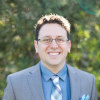What makes the Torah different from any other book we read?
I posed this question years ago to a group of second graders as we began a lesson about Simchat Torah.
“We read it from a scroll,” one student answered.
“It’s in Hebrew!” added another, excitedly.
“There are no pictures,” said a third.
Eventually, I encouraged students to notice what we do when we complete the yearly Torah reading and Sukkot comes to a close: We celebrate the completion of our annual cycle of sacred reading cycle by starting it all over again.
Whenever we complete a book, we usually move on to another. With Torah, the act of returning (or, ) to the beginning of the text cycle helps make our reading practice even more sacred or holy.
Over the centuries, the Jewish people have developed elaborate rituals and customs to celebrate this annual return to Torah’s opening chapter. We dance and sing as we welcome Torah back into our arms, even more than we would on a normal Shabbat or holiday. Some communities unroll the entire scroll, gently holding it open as a visible reminder of our people’s sacred story. One custom even encourages the Torah reader or chanter to say the last word of Deuteronomy and the first word of Genesis in the same breath. I have always found this idea beautiful and moving, as it suggests that we should not delay our re-reading, even for an instant!
If we pay close attention, we can even find a beautiful feature between the last and first Hebrew words—a heart. The last word of Deuteronomy is Yisrael, or Israel, as the book concludes with praising Moses for the “awesome power” he “displayed before all Israel” (Deut. 34:12). The first word of Torah, B’reishit, means “in the beginning” (Gen 1:1). When we combine the lamed, the last letter of Yisrael, with the bet, the first letter of B’reishit, we create the Hebrew word lev, which means “heart” – a reminder that very heart of Torah lies in starting it again and studying anew, year after year.
We can trace this idea of continually returning to Torah at least as far back as Pirkei Avot, a collection of our ancestors’ teachings included in the Mishnah. Rabbi ben Bag-Bag teaches:
“Turn it over, and [again] turn it over, for all is within it. Look into it and become old and frail within it, never moving away from it, for you have no better measure than it.” (Pirkei Avot 5:22)
By turning it again and again, we gain new wisdom from our Torah. We discover new ways to think about our lives, our choices, our history, and our future. As we grow from our childhood to old age, Torah always offers us an opportunity for reflection. Its words may not change, but we do. We notice new aspects of the stories and new details in . Each year, the same stories can echo very differently in our ears and inspire us to ask new questions.
Sacred reading creates deep relationships between ourselves and the text. And it’s not just a two-sided relationship; if we acknowledge the passage of time, there are at least three points: the text, who I am as I read it now, and who I was when I last read it. That triangular relationship takes on even more dimensions when we study with . Studying Torah as a community further embraces the meaning it can add to our lives and helps us grow exponentially.
Today, some communities apply these same ideas to secular texts. Fans of the Harry Potter series might know the podcast Harry Potter and the Sacred Text. The hosts, Casper ter Kuile and Vanessa Zoltan, read and discuss the beloved series one chapter per week, applying sacred reading practices to the books. One of the podcast’s guiding principles is that we, the readers and interpreters of text, must be the ones to make meaning from it. While it is yet to be determined if the podcast will continue after concluding the final book due to the deeply transphobic public statements made by the series’ author, J.K. Rowling, the hosts initially planned to start the series over. Upon learning this, I thought, “How Jewish!” It would be their version of Simchat Torah, reconnecting and renewing their reading of these beloved magical tales.
On its own, the Torah is inert. Our act of reading and learning from it again and again gives Torah the beating heart that has lived on in us for centuries. Torah becomes meaningful only when we bring it to the path of our life.
As we renew our connection to the heart of Torah, we turn our ancestors’ words into palaces of meaning. We begin again, taking comfort in the familiar, and inspiration from the ways that we will “turn it again” to reveal something new.
Explore Jewish Life and Get Inspired
Subscribe for Emails

